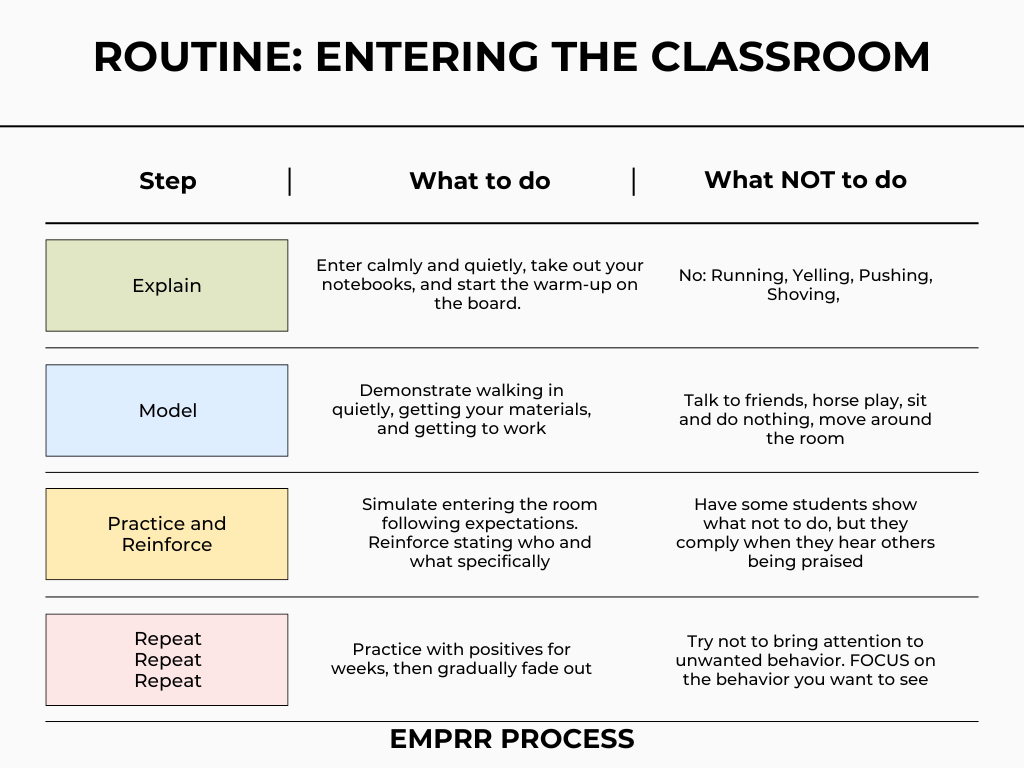Rules That Stick: The Brain-Based Way to End Repeat Reminders
Why teaching rules the brain-based way creates lasting classroom habits
“Come in quietly. Get started. Stop talking.” If you have said these words more times than you can count, you are not alone. The problem is not always defiance. Often, it is about how the brain forms habits—or fails to.
This article shares research-supported strategies for making rules and routines stick, paired with the brain science that explains why they work.
Why a Brain-Based Approach Works
Brains crave predictability, positive feedback, attention, and repetition. When teachers provide consistent, behavior specific praise, they strengthen the neural connections tied to positive actions. Over time, those connections become stronger and more automatic, turning desired behaviors into habits that students rely on.
Conversely, when the same corrections repeat day after day, the brain begins to expect them, unintentionally reinforcing the unwanted pattern. This is why how you introduce and practice rules matters just as much as what you teach.
Research consistently shows that rules stick best when they are introduced through explicit instruction, where expectations are clearly taught, modeled, and practiced until they become routine (Mathews and Cohen, 2022). This approach pairs naturally with consistent consequences, where every rule is tied to both positive and corrective feedback. One of the most effective tools for reinforcement is behavior specific praise, which immediately names what the student did well and why it matters (Sutherland, Wehby, & Copeland, 2000).
Why Explicit Instruction Makes Classroom Rules Stick: Brain Science Explained
Explicit instruction works because it mirrors the way the brain learns and stores new behaviors. Each step builds on the last, creating predictable neural pathways that support success:
Explaining helps students connect new information to prior knowledge, making it easier to retrieve later.
Modeling activates mirror neurons, which fire as if the student were performing the action themselves, priming the brain for imitation.
Practicing strengthens synaptic connections, making the behavior more automatic over time.
Reinforcing helps the brain correct prediction errors by rewarding accurate actions, increasing the likelihood they will be repeated.
Repeating increases myelination, which speeds and strengthens neural signals, moving the behavior toward habit status.
Research supports each step:
Mathews, H., and Cohen, A. (2022) – Clearly teaching and modeling expectations leads to faster skill acquisition and stronger retention.
Dufrene, B. A. (2019) – Consistent, specific feedback during practice significantly improves on-task behavior and engagement.
Sutherland, K. S., Wehby, J. H., and Copeland, S. R. (2000) – Higher rates of targeted praise reduce disruptions and increase time spent on learning tasks.
Explicit vs Implicit Rules: Watch How the Brain Responds
This 8 second video contrasts two common approaches to teaching classroom rules. In the explicit version, expectations are clearly taught, modeled, and practiced, helping the brain lock in the right behaviors. In the implicit version, students are left to interpret vague expectations, which often leads to confusion and inconsistent behavior.
When rules are taught explicitly, students’ brains can predict what will happen next, reducing anxiety and freeing attention for learning. Explore our BrainZones Model to see how brain-aligned strategies make consistent behavior automatic.
EMPRR Process (Explain, Model, Practice, Reinforce, Repeat): Classroom Routines Made Automatic
Each step of the EMPRR process provides clarity and builds a sense of security for students. When expectations remain consistent, their brains do not have to work as hard to predict what will happen next. This reduces cognitive load, freeing mental resources for deeper thinking and focus. BrainZones identifies this state as the Yellow Zone, where students are mentally ready to process and apply learning.
Over time, predictable routines foster what BrainZones calls the Green classroom. In this state, students are actively engaged, interacting with peers, and absorbing content in ways that strengthen both academic and social skills.
Research supports this structure. Clear, consistent routines reduce ambiguity and behavioral disruptions, allowing more instructional time to be devoted to learning (Emmer, E. T., and Evertson, C. M. 2017. Classroom Management for Middle and High School Teachers).
Explicit Instruction: Clearly teach and model what you expect.
Consistent Consequences: Tie rules to both positive and corrective feedback, with behavior-specific praise as one of the most effective reinforcement tools (Sutherland, K. S., Wehby, J. H., and Copeland, S. R. 2000. Effect of Varying Rates of Behavior Specific Praise on the On Task Behavior of Students with EBD).
A Coach's Game Plan: How the EMPRR Process Works
Think of a coach introducing a brand-new football play. They do not simply read through the “three-four defense” and then get frustrated when players fail to execute it. Instead, they explain the play, model it, often using veteran players or video for demonstration, and then have the team practice. They give targeted praise for correct execution, correct misunderstandings on the spot, and repeat the process multiple times.
Each run-through adds clarity and strengthens the brain’s neural pathways. This approach works because it aligns with how the brain learns: repetition combined with clear feedback enhances myelination, which speeds and strengthens signal transmission between neurons (Fields, R. D. 2015. A new mechanism of nervous system plasticity: activity-dependent myelination). Eventually, the players can run the play automatically, without conscious thought.
Why Repetition Makes Classroom Routines Stick: The Science of Learning
The brain quickly forgets what is not consistently reinforced. Without repetition, even well-taught routines begin to unravel, leading to more reactive behaviors. These inconsistencies keep students’ brains on alert, a high-energy state BrainZones identifies as the Orange Zone, where focus is harder to sustain.
When a behavior is intentionally repeated and reinforced, the brain strengthens its neural pathways through myelination, the process that makes signals travel faster and more reliably. This repetition turns productive actions into automatic habits. Once routines run on autopilot, students’ working memory is freed for deeper learning and higher-level thinking.
Research confirms that spaced repetition and consistent reinforcement improve long-term retention of both academic skills and behavioral expectations (Cepeda, Pashler, Vul, Wixted, & Rohrer, 2006).
Related Resource: See Motivating Positive Behaviors strategy in the CoreTex Library for step-by-step ways to make repetition engaging and effective.
Put EMPRR into Action Today
Strong rules and routines are not about control. They are about creating a predictable, supportive environment where students can thrive. The EMPRR process gives you a brain-based, step-by-step method to make expectations automatic and free students’ energy for learning.
Choose one routine you want to improve, apply EMPRR for the next two weeks, and watch your classroom shift. For strategies to help you get started, explore our CoreTex Library, including Motivating Positive Behaviors, Accountable Conversations, Circle of No Repeats, and Positive Endings.
If you are looking to strengthen your overall classroom culture, these teacher favorites will help you get there:
Here’s to fewer disruptions, more engagement, and a classroom that runs itself.
💡 We’d love to hear from you. Share your thoughts in the comments, or email us at team@brainzones.org.
📩 Follow us on: Facebook, Instagram, and linkedIn




